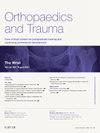腕部放射学
Q4 Medicine
引用次数: 0
摘要
手腕的解剖和生物力学是复杂的,关节可以受到各种病理的影响。在这里,我们解释了腕关节的放射解剖学与各种成像方式。创伤是手腕疼痛和残疾的主要原因,可能包括骨折、韧带和其他软组织损伤。舟状骨骨折可导致无血管坏死、骨不愈合和加速骨关节炎。固有韧带损伤会破坏舟状骨和斜方骨的正常生物力学关系,导致不稳定和舟月骨晚期塌陷。腕关节脱位是一种严重的损伤,包括月骨脱位,即月骨在掌侧方向脱位,或月骨周围脱位,即腕骨相对于月骨脱位。三角纤维软骨的撕裂可能是外伤性的或退行性的,MR关节摄影是最好的成像方法。远端尺桡关节不稳定的诊断可能是有问题的,但有各种方法可以采用,包括米诺,震中和一致性技术。腕关节可涉及所有类型的关节病,最常见的骨关节炎常见于拇指基部。类风湿关节炎是一种炎症性疾病,超声是评估活动性滑膜炎、腱鞘炎或肌腱断裂的一种非常敏感的检查。本文章由计算机程序翻译,如有差异,请以英文原文为准。
Radiology of the wrist
The anatomy and biomechanics of the wrist are complex and the joint can be affected by a wide range of pathology. Here, we explain the radiological anatomy of the wrist joint with respect to various imaging modalities. Trauma is a major cause of wrist pain and disability and can involve fractures, ligamentous and other soft tissue injuries. Fractures of the scaphoid can lead to avascular necrosis, non-union and accelerated osteoarthritis. Injuries of the intrinsic ligaments can disrupt the normal biomechanical relationship of the scaphoid and trapezium and cause instability and scapholunate advanced collapse. Carpal dislocations are severe injuries and include lunate dislocation, where the lunate dislocates in a volar direction, or perilunate dislocation, where there is dislocation of the carpus relative to the lunate. Tears of the triangular fibrocartilage can be traumatic or degenerate and are best imaged with MR arthrography. Diagnosis of distal radioulnar joint instability can be problematic but there are various methods which can be employed, including the Mino, epicentre and congruency techniques. The wrist joint can be involved in all types of arthropathy, most commonly osteoarthritis which is commonly seen at the base of the thumb. Rheumatoid arthritis is an inflammatory condition and ultrasound is a very sensitive examination for assessment of active synovitis, tenosynovitis or tendon rupture.
求助全文
通过发布文献求助,成功后即可免费获取论文全文。
去求助
来源期刊

Orthopaedics and Trauma
Medicine-Orthopedics and Sports Medicine
CiteScore
1.00
自引率
0.00%
发文量
57
期刊介绍:
Orthopaedics and Trauma presents a unique collection of International review articles summarizing the current state of knowledge and research in orthopaedics. Each issue focuses on a specific topic, discussed in depth in a mini-symposium; other articles cover the areas of basic science, medicine, children/adults, trauma, imaging and historical review. There is also an annotation, self-assessment questions and a second opinion section. In this way the entire postgraduate syllabus will be covered in a 4-year cycle.
 求助内容:
求助内容: 应助结果提醒方式:
应助结果提醒方式:


